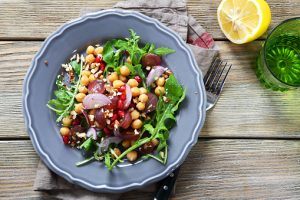 Diverticulitis is a condition characterized by inflamed or ruptured diverticula, which are bulging sacs in the lining of the large intestine. Picking the right foods to eat and steering clear of certain foods to avoid is important for effective management of diverticulitis symptoms.
Diverticulitis is a condition characterized by inflamed or ruptured diverticula, which are bulging sacs in the lining of the large intestine. Picking the right foods to eat and steering clear of certain foods to avoid is important for effective management of diverticulitis symptoms.
The risk of developing diverticula is usually higher for people over 40. Diverticula themselves do not cause many problems, but once the condition progresses into diverticulitis – when the sacs get inflamed or infected – it can be quite severe, leading to pain, nausea, and changes to bowels.
Advertisement
Mild diverticulitis can be easily treated with a proper diet. However, in cases of recurring and severe diverticulitis, surgery may be required.
Here we will outline the foods you should eat and the foods you should avoid if you are living with diverticulitis in order to promote healing all the while reducing symptom flare-ups.
Diet for diverticulitis
The purpose of a diverticulitis diet is to allow the digestive system to rest and to promote healing.
A diverticulitis diet mainly consists of liquids and soft food. In the beginning, stick to broths, juices, and water to prevent any further irritation or complications. Eventually, you can work your way up to eat more solid foods – which should include fiber-rich foods. It may be wise to start with low-fiber foods and work your way up to high-fiber foods to see how you feel along the way.
Studies have shown the fiber-rich foods can help manage symptoms related to diverticulitis. Recommended fiber intake is 25 grams for women under the age of 51 and 38 grams for men. For women and men over the age of 51, the recommended fiber intake is 21 grams and 30 grams a day respectively.
Fiber-rich foods include vegetables, whole grains, beans, and fruits. If you are not eating enough fiber, your doctor may recommend a fiber supplement to help give you a boost. It’s important, though, to stay well hydrated when you increase your fiber intake to avoid pain and constipation.
Foods to eat and avoid with diverticulitis
 As mentioned, foods you can eat are high-fiber foods for the most part, which are whole grains, rice, quinoa, vegetables, fruits like apples and bananas, potatoes, yogurt, and cottage cheese.
As mentioned, foods you can eat are high-fiber foods for the most part, which are whole grains, rice, quinoa, vegetables, fruits like apples and bananas, potatoes, yogurt, and cottage cheese.
At first, you may opt for low-fiber foods until you start feeling better, then you can incorporate high-fiber foods.
Make sure you drink plenty of fluid to avoid constipation.
Foods to avoid with diverticulitis include:
- Nuts
- Seeds
- Gassy vegetables like broccoli
- Whole grains that contain nuts or seeds
- Dried fruit
- Sugary foods and soda
- Acidic food
- Refined food
- Fried food
- Alcohol
- Corn and corn products
These foods can aggravate diverticulitis and prolong the healing period.
Other ways to maintain good digestive health and prevent diverticulitis
There are also some preventative measures you can try to lower your risk of diverticulitis.
Regular exercise, in particular, is beneficial for preventing diverticulitis because it helps keep bowels regular. Exercise also works to reduce pressure on the colon. Added pressure on the colon can lead to the formation of diverticula.
Advertisement
Other ways to maintain good digestive health include minimizing your intake of red meat, avoiding fatty foods, quitting smoking, maintaining a healthy body weight, responding to bowel urges, reducing your use of NSAIDs (which have been linked to diverticulitis bleeding), and staying well hydrated.
Tips to help promote healing of diverticulitis include:
- Resting your bowel – temporarily going on an all-liquid diet
- Killing off bad bacteria in the gut with oregano oil
- Re-populating the gut with good bacteria by taking probiotics
- Resolving nutritional deficiencies – talk to your doctor about multivitamin supplementation
- Detoxifying your environment – stop using toxic pans for cooking, for example
- Resolving constipation
By implementing these tips as well as following any diverticulitis treatment your doctor recommends, you can have better success in improving your digestive health while preventing and treating diverticulitis.

